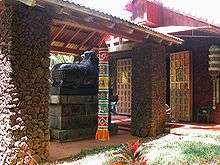Saiva Siddhanta Church
 Kadavul Temple at Kauai's Hindu Monastery | |
| Formation | 1949 (In United States) |
|---|---|
| Founder | Satguru Sivaya Subramuniyaswami |
| Type | 501(c)(3) |
| Headquarters | Hawaii, United States |
Official language | English |
Leader | Satguru Bodhinatha Veylanswami |
Staff | 21 monks, plus volunteers |
| Website | Śaiva Siddhanta Church |
Saiva Siddhanta Church is an organization that identifies itself with the Śaivite Hindu religion. It supports the work of the late Satguru Sivaya Subramuniyaswami 1927-2001, a spiritual teacher with the honorary title “Gurudeva.” The mission of the Church is to preserve and promote the Śaivite Hindu religion. Membership in the Church extends to many countries of the world, including the USA, Canada, Mauritius, Malaysia, Singapore, India, Sri Lanka and several European nations. Members are organized into regional Church missions with the goal of supporting Saivism in their families, communities, and in the global community under the leadership of Satguru Bodhinatha Veylanswami.
History
The Church was founded in 1949 by Satguru Sivaya Subramuniyaswami, a Saiva Hindu guru from the United States.[1] The name of the Church is from the Sanskrit language and could be roughly rendered in English as "The Church of God Śiva's Revealed Truth." The Saiva Siddhanta Church was incorporated under the laws of the United States of America in the State of California on December 30, 1957, and received recognition of its US Internal Revenue tax exempt status as a church on February 12, 1962. Among America’s oldest Hindu institutions, it established its international headquarters at Kauai Aadheenam, also known as Kauai's Hindu Monastery, on Kauai, Hawaii, on February 5, 1970.[2]
Purpose

The core purpose of the Church is to protect, preserve and promote the Saivite Hindu religion as embodied in the Tamil culture, traditions and scriptures of South India and Sri Lanka. It is based on the precepts of the Nandinatha Sampradaya, and traces its origins to a two-thousand-year-old lineage of the Kailasa Paramparā Gurus. The current head of the Church is Satguru Bodhinatha Veylanswami. The Church is oriented to serving those of Tamil descent, especially those from Sri Lanka. However, its membership is open to seekers of all ethnic backgrounds who wish to follow this ancient religious and cultural pattern. Currently, more than 85% of the global membership are born Hindus living, mostly, in Mauritius, Malaysia, Singapore, India and Sri Lanka. Many of the members living in the West are converts to Hinduism who live the path which leads souls through service, worship, sadhana and yoga toward God Realization.
The Saiva Siddhanta Church supports all major projects supervised by Satguru Bodhinatha Veylanswami, including:
- Construction of the Iraivan Temple on Kauai, a white granite stone Siva temple sculpted in India.
- Publication of the magazine Hinduism Today. The magazine is widely read among Hindus in India and in the worldwide diaspora. Thus, it provides an important means for worldwide networking, which is widely acknowledged.[3]
- Publication and distribution of books, booklets, and online material aimed at educating Hindus and non-Hindus about the Saivite Hindu religion.
- Teaching through lessons, literature, study courses, travel-study programs and youth retreats those actively pursuing the spiritual path under his guidance.
- Establishment and administration of charity organizations for Hindus worldwide.
Theology
The Saiva Siddhanta Church belongs to a monistic branch of the school of Saiva Siddhanta. Its theology is grounded in the Vedas, Saiva Agamas and the ancient Tirumantiram, a Tamil scripture composed by Tirumular. The Church's theology is based on a synthesis of devotional theism and uncompromising nondualism. It is referred to as "monistic theism", which recognizes that monism and dualism/pluralism are equally valid perspectives. God is both within us and outside of us, the Creator and the creation, immanent and transcendent. Satguru Sivaya Subramuniyaswami explains:[4] "The primary goal of monistic Saivism is realizing one's identity with God Siva, in perfect union and nondifferentiation. This is termed nirvikalpa samadhi, Self Realization, and may be attained in this life, granting moksha, permanent liberation from the cycles of birth and death. A secondary goal is savikalpa samadhi, the realization of Satchidananda, a unitive experience within superconsciousness in which perfect Truth, knowledge and bliss are known. Deep within our soul we are identical with God this very moment, for within us are the unmanifest Parasiva and the manifest Satchidananda. These are not aspects of the evolving soul, but the nucleus of the soul, which does not change or evolve. They are eternally perfect and one with God Siva. We are That. We do not become That.”
In the Press
Referring to the Iraivan Temple, New York Times reporter Michelle Kayal wrote:[5] ″This looks like India, but it is the Hawaiian island of Kauai, where members of the Saiva Siddhanta Church are erecting a white granite temple to the Hindu God Siva that fulfills the vision of their guru and is intended to last 1,000 years. For this act of devotion, every single piece of stone—3.2 million pounds in all—is being pulled from the earth by hand in India and carved into intricately detailed blocks using nothing but hammer and iron chisel.″ Since 1973 the Church has maintained a second temple at the Kauai Aadheenam, called Kadavul Hindu Temple, which has Siva Nataraja as the enshrined deity.
Notes
- ↑ Don Baker (31 May 2010). Asian religions in British Columbia. UBC Press. pp. 26–. ISBN 978-0-7748-1662-5. Retrieved 14 September 2011.
- ↑
- ↑ Frank Neubert (2010). "Western Hindus and 'Global Hinduism': Discourses on Conversion to 'Hindu Religions', Acceptance of Converts, and Social Engagement". Finnish Journal of Ethnicity and Migration, vol. 5. p. 61.
- ↑ Dancing with Siva ISBN 0-945497-97-0
- ↑ Kayal, Michele (7 February 2004). "Religion Journal; For Temple, 1,600 Tons, 8,000 Miles and 1,000 Years". The New York Times. p. 5.
External links
| Wikimedia Commons has media related to Saiva Siddhanta Church. |